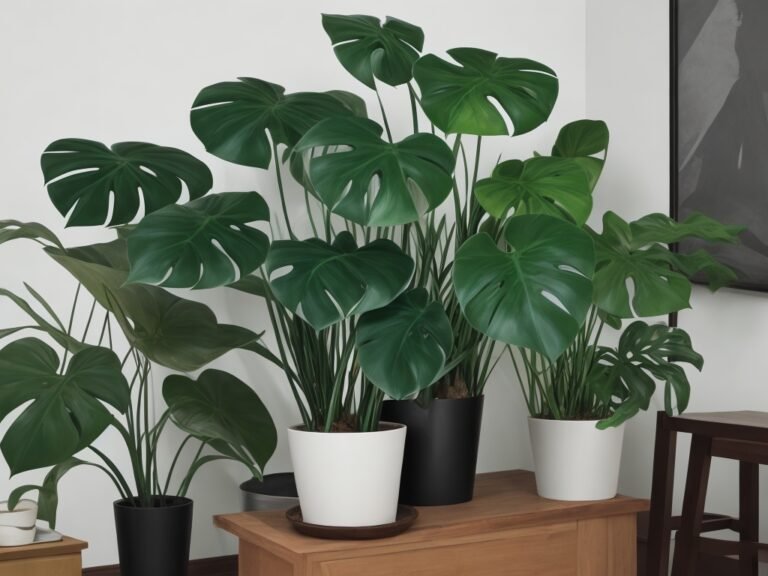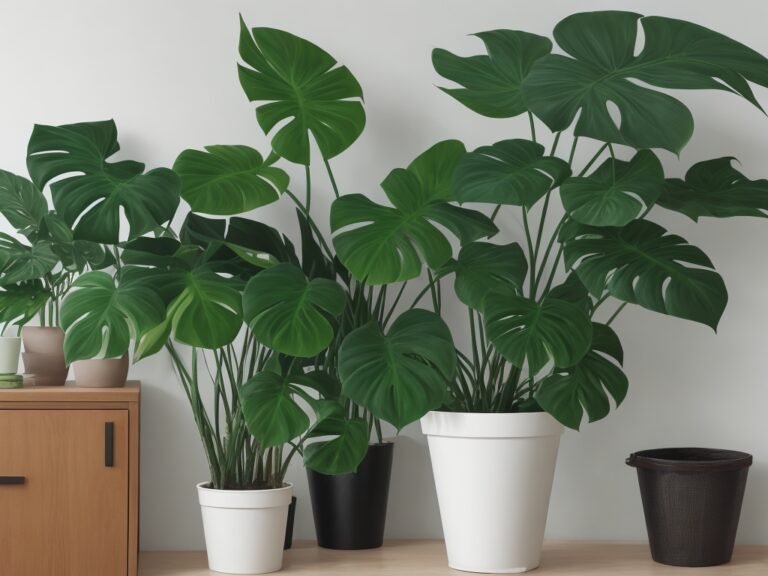Monstera Plant Care: Tips for Indoor Growth
Monstera plants are a popular choice for indoor gardening enthusiasts. These tropical beauties can add a touch of lush greenery to your home or office space. But, like any other plant, they require specific care to thrive indoors.
In this blog post, we will look in-depth at Monstera Plants and offer tips and tricks for their proper care and indoor growth.
We’ll cover everything from understanding the origins and varieties of Monstera plants to ideal environmental conditions for indoor growth.
We’ll also share insights on watering requirements, soil mix, fertilizing techniques, pruning, propagation methods, and troubleshooting common problems with these plants. Stay tuned till the end to learn if your Monstera plant can bloom indoors!
Understanding Monstera Plants
Monstera plants, commonly known as the swiss cheese plant, originate from southern Mexico. These tropical plants have large, attractive leaves with natural holes, giving them a distinctive appearance. They thrive in bright indirect light, making them perfect for indoor growth.
Monstera plants can develop aerial roots to support their long, sprawling growth. Proper care, including regular watering and using the right soil, is essential for maintaining the health of these beautiful plants.
Origins and Varieties of Monstera Plants
Monstera plants, scientifically known as monstera deliciosa, originate from the tropical rainforests of southern Mexico. Within the monstera family, there are several varieties, such as monstera adansonii and monstera peru, each displaying its unique leaf shape and size.
Belonging to the Araceae family, which includes popular house plants like pothos and philodendron, these tropical plants are often referred to as the fruit salad plant due to their leaves’ fruit-like appearance as they mature.
With their striking foliage and low maintenance needs, it’s no wonder that monstera plants have gained popularity as beautiful additions to indoor spaces.
Why Monsteras are Popular as Indoor Plants
Monsteras have gained popularity as indoor plants due to their tropical, exotic appearance. These plants can thrive in lower light conditions, making them suitable for various rooms in the house. With their large, beautiful leaves, monsteras can create a statement in any indoor space.
Whether you’re a beginner or an experienced plant owner, monsteras are relatively low maintenance, making them a perfect choice. It’s no wonder that the Swiss cheese plant has become a trendy house plant, frequently seen in interior design magazines and all over social media feeds.
Ideal Environment for Growing Monstera Indoors
To create the ideal environment for growing Monstera plants indoors, there are a few key factors to consider. These tropical plants thrive in bright indirect light, so it’s important to place them where they can receive plenty of natural light without being exposed to direct sunlight.
Maintaining a warm temperature between 65 and 85 degrees Fahrenheit is also crucial for their growth. Additionally, since Monstera plants are native to tropical regions, they prefer high humidity levels of 50% or higher.
Good air circulation is essential to prevent mold and fungus growth on the leaves. recommended to grow Monstera plantsonstera plants in pots with drainage holes to allow excess water to escape and prevent root rot.
Light Requirements for Monstera Plants
Monstera plants thrive in bright indirect light, such as near a north or east-facing window, mimicking the dappled light found in their natural habitat. It’s important to avoid placing them in direct sunlight as this can scorch the leaves.
If the light conditions are low, supplemental light from a grow light can be beneficial. Regularly rotating the plant ensures all leaves receive adequate light, preventing leggy growth. help your Monstera plant thrive indoors you can help your Monstera plant thrive indoors.
Preferred Temperature and Humidity for Monstera
Monstera plants thrive in temperatures ranging from 65 to 85 degrees Fahrenheit, similar to the average room temperature. While they can tolerate lower temperatures, growth may slow down during colder months.

High humidity levels, above 50%, are ideal for these tropical plants. To increase humidity, you can place the plant near a humidifier, group it with other plants, or mist the leaves.
Avoid exposing Monstera plants to drafty areas or heating vents, as fluctuating temperatures can cause stress.
Watering Your Monstera: How Much is Enough?
Finding the right balance in watering your Monstera plant is crucial. While they prefer moist soil, overwatering can lead to root rot. Water thoroughly, allowing excess water to drain out, and check the top inches of soil before watering again. Adjust the schedule based on season, humidity, and plant size.
Overwatering vs Underwatering: Spotting the Signs
Overwatering and underwatering can have detrimental effects on your Monstera plant. Overwatering can cause yellow leaves, root rot, and crispy spots on the leaves.
On the other hand, underwatering can cause drooping leaves, crispy leaves, and brown, crispy tips. To avoid these issues, use a moisture meter or monitor the weight of the pot to determine the moisture levels of the soil.
Remember to water the soil, not the leaves, and avoid overwatering or underwatering. Proper watering techniques will help keep your Monstera healthy and thriving.
The Right Soil Mix for Monstera Plants
To ensure the optimal growth of your Monstera plant indoors, it is crucial to provide it with the right soil mix. Monstera plants require well-draining soil to prevent waterlogged roots and potential root rot.
An ideal soil mix can be achieved by combining potting soil, perlite, and orchid bark. Additionally, enhancing drainage can be done by adding a layer of moss or pebbles at the bottom of the pot.
Avoid using soil that retains too much water, such as regular garden soil, as it can suffocate the plant’s roots. Regularly repotting your Monstera every 1-2 years not only refreshes the soil but also promotes root health.
Importance of Well-Draining Soil
Good drainage plays a crucial role in the care of Monstera plants, as it prevents the accumulation of excess water around the roots, which can lead to root rot.
By using well-draining soil, you create an environment that allows the roots to access the water they need while ensuring that any excess water is able to escape the pot. This promotes the health of the roots and supports the overall growth of the plant.
Investing in high-quality soil formulated for houseplants can give you better control over watering and contribute to the overall health of your Monstera plant.
Fertilizing Your Indoor Monstera
Promote growth in your indoor Monstera by using the right fertilizer. Opt for a fertilizer high in nitrogen to achieve lush, vibrant leaves. During the growing season, feed your Monstera every 2-4 weeks, ensuring the soil is moist before applying the fertilizer.
However, be cautious not to over-fertilize, as this can lead to root rot. By following these plant care tips, you can provide your Monstera with the ideal conditions for healthy growth and stunning foliage.
Choosing the Right Fertilizer
When it comes to choosing the right fertilizer for your Monstera plant, there are a few key factors to consider. First, look for a balanced, water-soluble fertilizer that will provide the necessary nutrients for your plant’s growth.
Additionally, opt for a fertilizer specifically formulated for house plants to ensure that it meets all their unique needs. If you prefer a more natural approach, organic fertilizers can be a great choice.
For long-term nourishment, consider using a slow-release fertilizer. Lastly, make sure to carefully read the instructions to avoid over or under-fertilizing your Monstera plant.
Pruning and Propagation Techniques for Monstera Plants
Pruning and propagation are important techniques for caring for your Monstera plant. To control its size and appearance, prune the plant as needed. This includes removing leggy growth to maintain a full and bushy plant. Additionally, you can propagate your Monstera by taking stem cuttings.
Simply place the cuttings in water or moist soil to encourage root growth. It’s best to perform pruning and propagation during the warmer months. These techniques will help you maintain a healthy and thriving Monstera plant.
When and How to Prune Your Monstera
Pruning your Monstera plant is best done during the early spring or summer months. To promote new growth, trim any yellow, damaged, or dead leaves using clean, sharp pruning shears.

Make clean cuts just above a node to encourage new growth. Pruning not only helps shape the plant but also removes any excess growth. It’s a great way to keep your Monstera looking beautiful and healthy. Remember to use the NLP terms as naturally as possible to enhance the content.
Troubleshooting Common Problems with Monstera Plants
Combatting yellow leaves and browning tips is essential for proper monstera plant care. Adjust watering to maintain moist, but not soggy, soil. Providing bright indirect light is crucial to prevent leggy growth. Regularly check for pests like spider mites or mealy bugs.
Additionally, maintaining high humidity levels is vital for the optimal health of your monstera. By addressing these common problems and implementing the necessary care, you can ensure your monstera thrives in its indoor environment.
How to Tackle Yellow Leaves and Browning Tips?
To tackle yellow leaves and browning tips on your Monstera plant, adjust watering to ensure the soil is moist but not waterlogged. Provide bright indirect light and increase humidity levels through misting or a humidifier. Check for root rot and ensure proper soil drainage. Trim yellow leaves and browning tips to promote new growth.
Can Monstera Plants Bloom Indoors?
Blooming indoors is rare for monstera plants, although large and mature plants have a higher chance. Mimic their natural habitat with bright indirect light and warm environments.
By providing proper care and watering, you can still enjoy the beauty of the monstera’s leaves, even without blooms.
Conclusion
In conclusion, Monstera plants are popular indoor plants that require specific care to thrive. Understanding their origins and varieties is important for providing the right environment for growth.
Proper lighting, temperature, humidity, watering, and soil mix are crucial factors in maintaining the health of your Monstera plant. Regular pruning, fertilizing, and troubleshooting common problems will ensure its longevity.
While Monstera plants can be challenging to bloom indoors, creating the ideal conditions may encourage flowering. By following these tips for indoor growth, you can enjoy a beautiful and healthy Monstera plant in your home.






